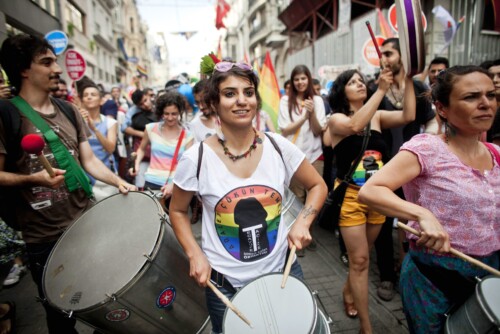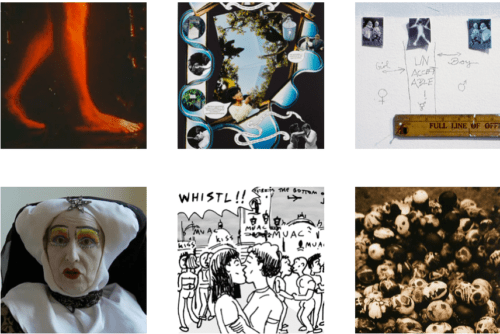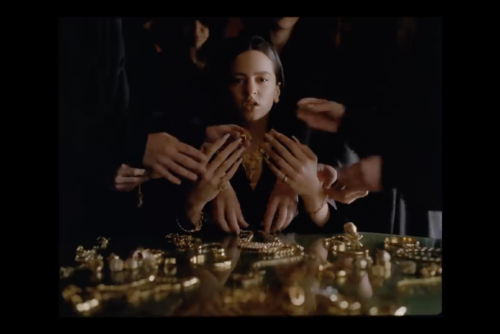In the last couple of decades, there has been considerable anxiety among queer theorists and activists regarding the influence in India of Western categories, terminology and forms of activism. The anxiety about Western influence is not unique to queer movements. Educated Indians, in the aftermath of colonialism, have continued a love-hate relationship with the West that began in the eighteenth century. This is common both to the left and the right and most formations in between. While actively imbibing and even seeking out Western influence Indians tend simultaneously to denounce it.
Among the first to raise the question in relation to India were Shivananda Khan, founder of Naz Foundation in the UK, and British journalist Jeremy Seabrook.1 Their argument that “gay,” “lesbian” and other such identity categories are Western impositions on non-Western countries is a globalizing one, that scholars had already applied to other countries,2 and continue to apply on a global scale.3
Seabrook (followed by many South Asianist scholars, most of whom linked the question to that of globalization and neo-colonialism)4 argued that Indian conceptions of sexuality were based on sex acts, not identity, and were divided into a penetrating masculinized partner and a penetrated feminized one (women do not appear in this argument). He therefore concluded that those (a category which would include millions of modern Indians) who use terms like “lesbian” and “gay” are the elite descendants of colonial officials, and are “striking violently against the multiple competing aspects of the human person in traditional societies.”5 Pioneering Indian gay activist Ashok Row Kavi, founder of Humsafar Trust (which uses a whole range of terms, including “gay,” “lesbian,” kothi, panthi, hijra, MSM), contested this view, remarking that Seabrook (whose pan-Indian argument in his book was based on interviews in a cruising park in Delhi that he wrote up later from memory) “had better visit many more parks in India” before affirming such conclusions.6 In a review, Rachel Dwyer remarked that Seabrook’s title was misleading since his book was about sex, not love, and added, “so many epistemological categories in India are western imports; the trap is of seeking an essential, unchanging, ahistorical ‘Indian sexuality.’”7
Some NGOs prefer slang words of recent provenance like kothi and giriya for men, even though these are region-specific terms now being claimed as pan-Indian; these choices often have much to do with claiming indigeneity in order to attract foreign funding.8 Other NGOs use MSM (men who have sex with men) as an identity category more suitable for Indian men, because it focuses not on identity but on behavior. This argument is self-contradictory because “MSM” was coined by health workers in the U.S. with regard to American men, not as an identity category but as a medical term for use in the context of HIV prevention efforts.9
There are several Indian-language terms that could be revived (dogana [double self, female who loves other women] chapatbaz [woman who engages in female-female sex] amradparast [male worshiper of young males] in Urdu, swayamvara sakhi [self-chosen female friend of a female] in Sanskrit/Hindi are ones Kidwai and I identified in Same-Sex Love in India [2000]), but all are language-specific, since India has about 15 major languages with their own scripts and literary histories.10 There are also derogatory terms, some of which could perhaps be reclaimed the way “queer” has been. I recently had an online discussion with a Hyderabad-based activist about whether one such term, gaandu (man who engages in anal sex) could be reclaimed.
The debate about terminology derives from the Foucauldian claim that nineteenth-century Euro-American sexologists were the first to invent sexuality-based identity categories, and that prior to this invention, a range of sexual behaviors existed but were not perceived or named as defining individuals, groups or relationships.11 Historians have repeatedly disproved this latter claim, both for the West and for India, yet it persists. Identity terms like “Ganymede,” “tribade,” “Sapphist,” and even “lesbian” were used in Europe as early as, in one case, the tenth century, and certainly from the Renaissance onward, to mark individuals habitually given to same-sex sexual relations.12
In the context of India, Michael Sweet and Leonard Zwilling have demonstrated the formulation of sexual categories in Hindu and Jain texts as early as the sixth century B.C.13 The Kamasutra (fourth century AD), mentions casual as well as long-term sexual relations between men, but it also constructs a category of the “third nature,” consisting of men who desire men, and notes that while some persons of the third nature are masculine-appearing, others are feminine-appearing; it suggests that the former find male partners by working in professions like hairdressing, massage, and flower selling. Scholars of the medieval Islamicate have written both on male-male love and on the representation of female-female love by male writers.14
Transnational Eclecticism
When protesting injustice, such as the hounding to death of Prof. Srinivas Ramachandra Siras at Aligarh Muslim University in 2010 on account of his homosexuality, or the Indian Supreme Court’s reinstatement of the anti-sodomy law (Section 377 of the Indian Penal Code) in 2013, activists in India have not spent much time worrying about the issue of Western influence, but have drawn eclectically on different terminologies and traditions of protest, both Indian and Western.
For instance, Voices Against 377, a coalition of twelve Delhi-based organizations, which organized several meetings of organizations from around the country, uses the term “same-sex desiring people,” which it defines as “including those who identify as lesbian, gay, bisexual and transgender (LGBT), hijra, kothi and other queer people.”15 Likewise, Sappho for Equality, founded in Kolkata in 1999, states that it derives its name from “the legendary Greek poet of 6th century BC,” and defines itself as “an emotional support group for lesbians, bisexual women and female to male transpersons.” Its statement that it has “its base in Kolkata and members around the globe” can be read as reconfiguring the idea of center and margins.16
The reconfiguring is more self-conscious in the case of Delhi-based feminist human rights organization CREA. Founded in 2000, it organizes sexuality studies institutes and workshops, both general and specific (on such issues as disability) in places ranging from Khandala, a small town in Maharashtra, to Istanbul and New York. These workshops, taught in both English and Hindi, draw a range of national and international activists, scholars, students and teachers. CREA describes itself as “one of the few international women’s rights organisations based in the global South, led by Southern feminists, which works at the grassroots, national, regional, and international levels. Together with partners from a diverse range of human rights movements and networks, CREA works to advance the rights of women and girls, and the sexual and reproductive freedoms of all people. CREA advocates for positive social change through national and international fora, and provides training and learning opportunities to global activists and leaders through its Institutes.”17
A fourth innovative institution is Queer Ink, founded in Mumbai in 2010 by Shobhna Kumar, a Fijian woman of Indian origin who grew up in Fiji, has lived in Australia and the US, and now lives in India for the last 14 years. It began as an online retail store for books on sexuality and gender, since many of these are not easily available in other stores, and has now developed a variety of activities, including a queer book fair, a monthly festival QFest, film screenings, lectures, and the publication of a series of books and videos. Perhaps most interestingly, it has launched an online article series called Janata Bol (People Speak) complemented by a series of informal chats about the Constitution of India called Nagrik Nukkad based on the traditional idea of the street-corner (nukkad) chat.18 This group with a founder who is herself transnational, uses a transnational format (the internet) to intervene in local as well as global debates, using both local (nukkad) and global (queer) terms.
A good example of the local modifying the global was transgender activist Abheena Aher’s performance at the Global Day of Rage in Delhi, on 15 December 2013, immediately after the Supreme Court judgment reinstated the anti-sodomy law. She danced to the iconic song “Pyar kiya to darna kya” (We love, what is there to fear?) from the Bombay movie Mughal-e Azam, 1960.
A defiant dancer sings the song in the presence of the Mughal Emperor who has forbidden her, on pain of death, to continue her romance with his son. This ungendered song, which most Indians grow up hearing, has been informally adopted as a gay anthem in India. The few Westerners present at the rally are likely to have been mystified by the crowd’s emotional response to the song.19
The rest of this paper explores the way effective transnational activism may benefit from certain principles of action: 1. Acquiring knowledge of historical cross-cultural connections and building on these 2. Acknowledging that such connections have been and still are two-way, not one-way 3. Letting local activists take the lead, and 4. not assuming that positive change must always follow the same trajectory.
- Jeremy Seabrook, Love in a Different Climate: Men who have Sex with Men in India (Verso, 1999). [↩]
- D. Altman, “Rupture or Continuity: the Internationalization of Gay Identities,” Social Text48 (1996), 77-94; D. Altman, “Global Gaze/Global Gays,” GLQ 3:4 (1997), 417-36. [↩]
- D. Altman, Global Sex (Chicago & London: University of Chicago Press, 2001); Arnaldo Cruz Malave and Martin F. Manalansan, ed., Queer Globalizations: Citizenship and the Afterlife of Colonialism (New York: New York University Press, 2002); D. Donham, “Freeing South Africa: The “Modernization” of Male-Male Sexuality in Soweto,” in J.X. Inda and R. Rosaldo ed., The Anthropology of Globalization: A Reader, (Malden, MA: Blackwell Publishing, 2002), 410-427.; K. Kollmann and M. Waites, “The Global Politics of Lesbian, Gay, Bisexual and Transgender Human Rights: An Introduction,” Contemporary Politics 15: 1 (2009), 1-17. Some scholars place identity categories in quote marks to indicate their supposedly less-than-real nature in non-Western countries, for example, Amanda Lock Swarr and Richa Nagar, “Dismantling Assumptions: Interrogating “Lesbian” Struggles for Identity and Survival in India and South Africa,” Signs 29: 2 (Winter 2004), 491-516. [↩]
- See, for example, I. Grewal and C. Kaplan, ‘Global identities – Theorizing transnational studies of sexuality’ GLQ: A Journal of Lesbian & Gay Studies 7: 4 (2001), 663-679; Aniruddha Dutta, “Legible Identities and Legitimate Citizens: The Globalization of Transgender and Subjects of HIV-AIDS Prevention in Eastern India,” International Feminist Journal of Politics 15:4 (2013), 494-514. [↩]
- Jeremy Seabrook, “It’s Not Natural,” The Guardian,July 3, 2004, https://www.theguardian.com/world/2004/jul/03/gayrights.comment, accessed November 16, 2015. [↩]
- Ashok Row Kavi, “Same-Sex Love in India,” Gay Today, http://www.gaytoday.com/garchive/reviews/082100re.htm, accessed November 16, 2015. [↩]
- Rachel Dwyer, “Not Gay: Just Busy Having Fun,” Times Higher Education February 25, 2000, https://www.timeshighereducation.com/books/not-gay-just-busy-having-fun/157047.article, accessed November 16, 2015. [↩]
- See Lawrence Cohen, “The Kothi Wars: AIDS Cosmopolitanism and the Morality of Classification,” Sex in Development: Science, Sexuality, and Morality in Global Perspective, ed., Vincann Adams and Stacy Leigh Pigg (Durham: Duke University Press, 2005), 269-303. See also Paul Boyce, “Conceiving Kothis: Men who have Sex with Men in India and the Cultural Subject of HIV Prevention,” Medical Anthropology 26:2 (2007) 175-203. [↩]
- See Rebecca M. Young and Ilan H. Meyer, “The Trouble with ‘MSM’ and ‘WSW’: Erasure of the Sexual-Minority Person in Public Health Discourse,” American Journal of Public Health 95: 7 (July 2005), 1144-1149. [↩]
- Following the publication of Same-Sex Love in India, individuals have occasionally used these terms, for example, one woman took the Facebook sobriquet Dogana Chapatbaz. [↩]
- This idea was formulated by Michel Foucault, The History of Sexuality Volume. 1, trans. Robert Hurley (New York: Random House, 1978; French original 1976), and reworked by his followers, most notably David M. Halperin, One Hundred Years of Homosexuality and Other Essays on Greek Love (New York: Routledge, 1990). I use the term “Foucauldian” because I agree with Lee Siegel, (“Queer Theory, Literature and the Sexualization of Everything: The Gay Science,” in Theory’s Empire: An Anthology of Dissent ed. Daphne Patai and Wilfrido Howard Corral [New York: Columbia University Press, 2005], 424-40), that Foucault’s followers, such as Halperin and Eve Kosofsky Sedgwick, have misapplied his theories. [↩]
- John Boswell, Christianity, Social Tolerance and Homosexuality (Chicago: University of Chicago Press, 1980) for “Ganymede” and “sodomite;” Bernadette J. Brooten, Love between Women: Early Christian Responses to Female Homoeroticism (Chicago: University of Chicago Press, 1996) for a tenth-century use of “lesbian” to connote a woman who has sex with women; Emma Donoghue, Passions between Women: British Lesbian Culture 1668-1801 (New York: Harper Collins, 1993), for “tribade,” “lesbian,” and other such terms. [↩]
- Michael J. Sweet and Leonard Zwilling, “The First Medicalization: The Taxonomy and Etiology of Queers in Classical Indian Medicine,” Journal of the History of Sexuality 3:4 (1993): 590-607, and “ ‘Like a City Ablaze’: The Third Sex and the Creation of Sexuality in Jain Religious Literature,” Journal of the History of Sexuality 6:3 (1996): 359-84. [↩]
- For the Kamasutra, see my essay in Ruth Vanita and Saleem Kidwai, Same-Sex Love in India: Readings from Literature and History (New York: St. Martin’s, 2000; New Delhi: Macmillan, 2002), 46-54; for the Islamicate, see Saleem Kidwai, “Introduction to Medieval Materials in the Perso-Urdu Tradition,” ibid, 107-25. Giti Thadani, Sakhiyani: Lesbian Desire in Ancient and Modern India (New York: Cassell, 1996) briefly surveys female homoeroticism in some ancient and modern Indian texts. [↩]
- http://www.voicesagainst377.org, accessed November 16, 2015.
[↩] - http://www.sapphokolkata.in/sappho/, accessed November 16, 2015. [↩]
- http://www.creaworld.org/who-we-are/about-us, accessed November 16, 2015 [↩]
- http://queer-ink.com/nagrik-nukkad/ accessed on November 16, 2015. [↩]
- accessed November 17, 2015. [↩]




